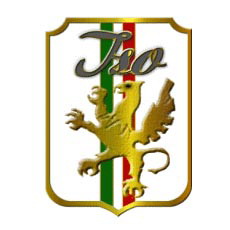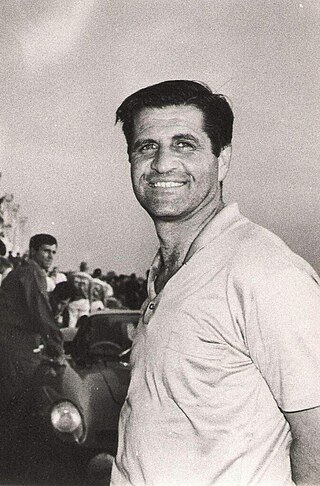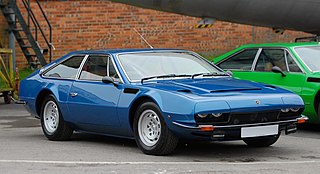
The Firenza is a model of car offered by Vauxhall from May 1971 until 1975. It was a development of the Viva, but had a distinctive coupé body style (fastback) and only two doors. In South Africa, it was sold as the Chevrolet Firenza until it was replaced by the Chevrolet 1300/1900 during 1975. Its name is derived from Firenze, the name of the Italian city known in English as Florence.

The Chevrolet El Camino is a coupé utility vehicle that was produced by Chevrolet between 1959–60 and 1964–1987. Unlike a standard pickup truck, the El Camino was adapted from the standard two-door Chevrolet station wagon platform and integrated the cab and cargo bed into the body.

ISO Rivolta is an Italian car and motorbike manufacturer active in the motor vehicle sector since 1938. Over the years, the company has taken various names, including Isothermos, Iso Autoveicoli Spa in 1952, Iso Rivolta in 1962, Iso Motors in 1973 and, in 2017, a return to ISO Rivolta.

Bizzarrini S.p.A. was an Italian automotive manufacturer founded by Giotto Bizzarrini an Italian engineer born in Livorno, Tuscany in1926 and died on May 13 2023: in 1964 the automotive company was founded by former Alfa Romeo, Ferrari and Iso engineer Giotto Bizzarrini. The company built a small number of highly developed and advanced sport and racing automobiles before failing in 1969: in 2020, it was announced that the name had been acquired by Pegasus brands, together with plans to restart production.

Giotto Bizzarrini was an Italian automobile engineer who was active from the 1950s through the 1970s.

The Bizzarrini Strada, is a sports car produced by Bizzarrini from 1964 to 1968. Sold as an exceptionally low slung, two-seat coupé, roadster, and track-tuned "Corsa" racer, it proved to be Bizzarrini's most successful model.

The Ferrari 250 GT SWB Breadvan is a one-off Ferrari made in 1962 from a 1961 Ferrari 250 GT Berlinetta SWB, chassis number 2819 GT. It was built to compete against the new 1962 Ferrari 250 GTO at the 24 Hours of Le Mans and other FIA World Sportscar Championship races.

The 1957 Chevrolet is a car that was introduced by Chevrolet in September 1956 for the 1957 model year. It was available in three series models: the upscale Bel Air, the mid-range Two-Ten, and the One-Fifty. A two-door station wagon, the Nomad, was produced as a Bel Air model. An upscale trim option called the Delray was available for Two-Ten 2-door sedans. It is a popular and sought after classic car. These vehicles are often restored to their original condition and sometimes modified. The car's image has been frequently used in toys, graphics, music, movies, and television. The '57 Chevy, as it is often known, is an auto icon.

The Lamborghini Jarama is a 2+2 grand tourer manufactured and marketed by Italian car manufacturer Lamborghini between 1970 and 1976. It was styled by Bertone designer Marcello Gandini.

Frank Williams Racing Cars was a British Formula One team and constructor.

The Iso Grifo is a limited production grand tourer manufactured by Italian automobile manufacturer Iso Autoveicoli S.p.A. between 1965 and 1974. Intended to compete with Grand Touring offerings from Ferrari and Maserati, it used a series of American power trains and components supplied by Chevrolet and Ford. Styling was done by Giorgetto Giugiaro at Bertone, while the mechanicals were the work of Giotto Bizzarrini.
Callaway Cars Inc. is an American specialty vehicle manufacturer and engineering company that designs, develops, and manufactures high-performance product packages for cars, pickup trucks, and SUVs. They specialize in Corvettes and GM vehicles. New GM vehicles are delivered to Callaway facilities where these special packages and components are installed. Then the vehicles are delivered to GM new car dealers where they are sold to retail customers, branded as Callaway. Callaway Cars is one of four core Callaway companies, including Callaway Engineering, Callaway Carbon and Callaway Competition.

The second-generation Chevrolet Camaro is an American pony car that was produced by Chevrolet from 1970 through the 1981 model years. It was introduced in the spring of 1970. Build information for model 123-12487 was released to the assembly plants in February of that same year. It was longer, lower, and wider than the first generation Camaro. A convertible, which was available for the first generation, was unavailable for the second. GM engineers have said the second generation is much more of "A Driver's Car" than its predecessor.

The Iso Fidia, initially Iso Rivolta S4, is a four-door sedan which was produced by the Italian automobile maker Iso Automoveicoli S.p.A. from 1967 to 1975. The Fidia, first presented at the Frankfurt Motor Show in September 1967, was the only four-door model from Iso. Production only got underway some time after the initial presentation of the car, and its European press launch which took place in Athens, came more than a year later, in February 1969. At the time of the press launch 15 cars had already been built, but it was only in February 1969 that the car swapped its "S4" name for the more euphonious "Fidia". The car was marketed as a unique combination of comfort and sporting performance, and the slogan that appeared in sales material was "Le quattro poltrone piu veloci del mondo".

The Chevrolet 400 was a compact car made by General Motors de Argentina from 1962 to 1974. The "400" was General Motors's reply to Ford and Chrysler after those companies introduced the first compact cars to Argentina, the Ford Falcon and Valiant II respectively.

The Iso Rivolta is a grand tourer introduced in 1962 by Italian automobile manufacturer Iso Automotoveicoli S.p.A. Company chairman Renzo Rivolta and his colleague, former Ferrari engineer Giotto Bizzarrini, saw it as a gran turismo in the original sense of the term, designed for long and memorable journeys. It was the first luxury automobile introduced by the company which formerly specialised in affordable motor vehicles. For motor racing, an entirely different variant was made which bore a strong resemblance to the 1962 model Ferrari 250 GT SWB Breadvan and was homologated as a touring car.

Renzo Rivolta was an Italian Engineer.
The Iso Varedo was a concept car produced by Italian car manufacturer Iso Autoveicoli S.p.A. in 1972 styled by Ercole Spada. It was unveiled at the 1972 Turin Motor Show. Only one Varedo was ever built. It currently resides at the Sarasota Classic Car Museum in Florida.

Automobili Lamborghini S.p.A. is an Italian brand and manufacturer of luxury automobiles. Lamborghini's production facility and headquarters are located in Sant'Agata Bolognese, Italy. Italian manufacturing magnate Ferruccio Lamborghini founded the company in 1963 with the objective of producing a refined grand touring car to compete with offerings from established marques such as Ferrari. The company's first models were introduced in the mid-1960s and were noted for their refinement, power and comfort. Lamborghini gained wide acclaim in 1966 for the Miura sports coupé, which established rear mid-engine, rear wheel drive as the standard layout for high-performance cars of the era.

The Williams FW was a Formula One car used by Frank Williams Racing Cars during the 1973, 1974 and 1975 seasons. It was designed by John Clarke.




















